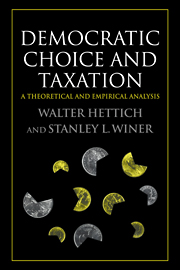Book contents
- Frontmatter
- Contents
- Preface
- 1 Introduction
- PART ONE THEORETICAL FRAMEWORK
- PART TWO COLLECTIVE CHOICE AND THE NORMATIVE ANALYSIS OF TAXATION
- 5 An Assessment of Normative Tax Theory
- 6 Welfare, Politics, and Taxation
- PART THREE APPLIED GENERAL EQUILIBRIUM ANALYSIS
- PART FOUR STATISTICAL ANALYSIS OF TAX STRUCTURE
- PART FIVE POLITICAL INSTITUTIONS AND TAXATION
- Bibliography
- Name Index
- Subject Index
6 - Welfare, Politics, and Taxation
Published online by Cambridge University Press: 08 October 2009
- Frontmatter
- Contents
- Preface
- 1 Introduction
- PART ONE THEORETICAL FRAMEWORK
- PART TWO COLLECTIVE CHOICE AND THE NORMATIVE ANALYSIS OF TAXATION
- 5 An Assessment of Normative Tax Theory
- 6 Welfare, Politics, and Taxation
- PART THREE APPLIED GENERAL EQUILIBRIUM ANALYSIS
- PART FOUR STATISTICAL ANALYSIS OF TAX STRUCTURE
- PART FIVE POLITICAL INSTITUTIONS AND TAXATION
- Bibliography
- Name Index
- Subject Index
Summary
The problem of efficiency, however, is so vital that we cannot ignore it merely because our answers to it are not complete. Welfare economics, despite its limitations, provides partial answers; and I feel that to provide partial answers to vital problems is at least as important as it is to provide complete answers to lesser questions.
Tibor Scitovsky (1951, p. xi)This chapter represents an exploration of a more inclusive welfare economics of taxation. Its nature, like that of any new enterprise, is of necessity somewhat tentative. The emphasis is on presenting an outline of ideas and illustrating them with relevant examples. Whereas some sections develop a formal analysis, others take a more intuitive approach. The organization of the material is based on the conclusions reached in the preceding chapter, where we sketched three steps required for a comprehensive welfare analysis in the presence of collective choice. (See Section 5.3.)
We begin here with the selection of the standard of reference against which to judge collective choice outcomes. This, together with a consideration of the conditions under which equilibrium policy outcomes will achieve the standard, constitutes the first step. Economists have devoted much effort to working out such an analysis for an economy with private markets, and it has been one of the important achievements of the discipline to show that an economic system with competitive markets will yield optimal (Pareto-efficient) outcomes under carefully defined conditions.
- Type
- Chapter
- Information
- Democratic Choice and TaxationA Theoretical and Empirical Analysis, pp. 121 - 150Publisher: Cambridge University PressPrint publication year: 1999



